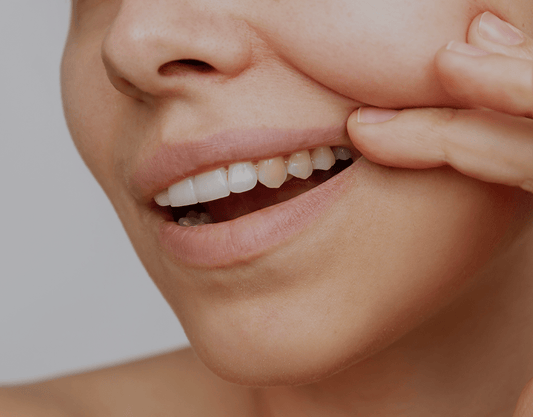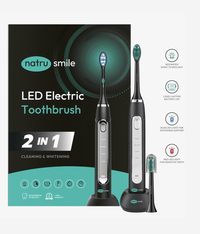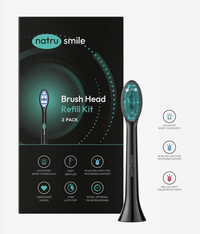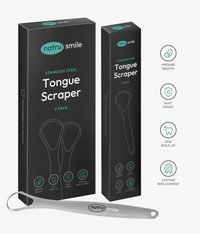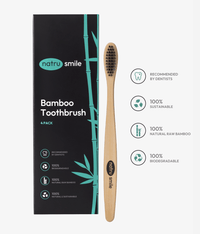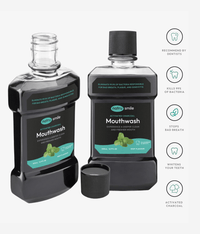
All products are certified by dental expert Dr. Greg Grillo
Uneven teeth whitening isn't what you'd call a pleasant experience. Whether it comes from a botched at-home treatment or just teeth being teeth, you might wonder whether you can last while keeping your mouth closed for the entire day.
So, naturally, your next question is probably this: how can I make my teeth evenly white again? Even once you get through this answer, you'll want to take steps to prevent it in the future.
In this article, you'll find out more about what causes uneven color, how to fix it, and how to prevent it in the future.
What Causes Uneven Color After Teeth Whitening?
The most common cause of uneven color after teeth whitening is the uneven application of products used. This can happen with the bleaching gel at your professional dentist and the peroxide solution in your at-home teeth whitening kits.
In some cases, this can be a fault of the product. Whitening strips, for example, are tricky to get on your teeth. So, it's normal for them to miss a few gaps.
The shape of your tooth can be an unusually uneven surface, especially as you transition from your molars to incisors. Even some whitening trays might not fit your mouth correctly, causing the whitening solution to pool in unusual spots.
While home teeth whitening cost is cheaper because you are more likely to make mistakes, professionals aren't immune from this. When looking at in-office teeth whitening options, mistakes can still happen there.
Older forms of whitening, like teeth bleaching, are more likely to run into these issues. However, laser teeth whitening might also miss, as the dentist needs to leave behind an even coating of whitening gel.
If the dentist isn't focused or hasn't had their morning coffee, they might not perform with any level of care. Even if someone has a degree and years of training, they can still make mistakes.
Another cause of uneven whitening that happens because of whitening is the weakening of enamel. As the enamel weakens, it reveals the underside (known as dentin), which is much yellower than the tooth's surface.
If you whiten your teeth too much, it can lead to dentin exposure. But this can also happen due to age (as your gums start to recede).
How To Fix Uneven Teeth Color After Whitening
If you see an uneven shade or discoloration after whitening, your first step depends on whether it was done at home or with a professional.
If you see spotty whitening after leaving your dentist, contact them. A good cosmetic dentist should take pride in their work. Knowing that any customer going out with teeth issues could ruin their reputation, the cosmetic dentist should schedule you for an appointment.
If they don't reschedule you or show signs that they don't care, that's a sign you need to move on and find another dentist.
This also allows you to ask your dentist for temporary solutions. Life doesn't stop, even for blotchy teeth.
Even if you use an over-the-counter whitening kit, contacting a dentist is a good move. After all, professional advice can prevent you from damaging your teeth.
Once you get that advice, try other natural whitening remedies (based on a dentist's recommendation). For example, you can use baking soda or hydrogen peroxide to whiten the areas of your teeth that are more noticeably stained. Spot treatment is a great way to get back that smile.
Alternatively, you could use your regular toothpaste and mouthwash. A good, normal teeth cleaning might work to normalize your mouth. According to many studies, fluoride-containing toothpaste can remineralize your teeth according to many studies, which can lead to them regaining their strength. Strong teeth tend to be whiter and easier to whiten.
How To Prevent Uneven Teeth Whitening Results
If you've solved the short-term problem of getting your teeth white again, you can focus on the long-term problem: prevent a blotchy whitening job.
Of course, if your uneven teeth whitening comes from a dentist that doesn't care, start by finding a new dentist. In other cases, you can follow these tips to prevent spotty whitening:
Use Custom-Fit Whitening Trays
Custom-fit whitening trays are built specifically for your mouth. The custom fit is designed to ensure that the teeth whitening solution gets where it needs to go.
This way, you don't have to worry about pooling whitener, which can lead to sensitive teeth. There are also other teeth-whitening side effects.
Custom-fit whitening trays often come by visiting a cosmetic dentist. After measuring you for a fit, they build a tray for your whitening solution. You are meant to take this home and use it during the day.
You can get over-the-counter trays, but these aren't custom. Custom trays might be more expensive, but they tend to be worth it if you want to guarantee even results.
Avoid Staining Food And Drink
Coffee, tea, and soy sauce are all liquids with intense pigments for food and drink. These foods (and foods like these) should be avoided, so you don't stain your teeth.
The "uneven" whitening look might have come from staining. If you ate after whitening, think about what you ate.
Many individuals who pursue white teeth stick to a "white diet." This diet includes foods without strong pigments that won't stain teeth.
Don't Use Over-the-Counter Bleaching Agents
You run a higher risk of uneven staining whenever you use DIY whitening kits. This comes from needing more direction, as some of the steps in these kits aren't easy to follow. It also doesn't help that these teeth whitening kits are sometimes small and hard to control.
Using these bleaching agents means you must be in charge of your whitening. Much like shaving for the first time, you are bound to nick yourself (or whiten unevenly, in this case). Of course, you always want to practice good teeth whitening safety.
If choosing at-home whitening remedies, consider those that don't require precision. Using baking soda or hydrogen peroxide is no different from brushing your teeth. You might also consider whitening toothpaste.
Have Your Teeth Cleaned First
The foundation of healthy, white teeth starts with clean teeth. If you want to improve your smile through whitening, it begins with an excellent oral health care routine.
If any plaque or debris is left behind during the whitening, you won't be whitening your teeth; you'll be whitening the other things in your mouth. So, when you eventually remove those things through regular tooth care, your teeth will look uneven.
Good cosmetic dentists will thoroughly clean before starting any whitening procedure. But you'll want to brush your teeth day and night, use mouthwash, and floss in the weeks before your appointment.
If whitening using over-the-counter products, consider a professional cleaning from your regular dentist.
Don't Panic
Above all, if you have uneven teeth, don't panic. Panicking won't help because you'll want to spend that energy thinking about solutions.
Start with diaphragmatic breathing, or deep breathing, to help remove the anxiety from your body. Once you calm down, you can begin to think of solutions.
Start with the logical progression of steps leading to your teeth becoming unevenly white. Once you find out the cause of it, you can take measures to prevent it in the future.
Remember, you aren't your teeth, so the fact that your pearly whites aren't so white (for now) isn't a reflection on yourself. It's just something that happened, which is okay. Things happen.
Wrapping Up
Uneven teeth color is often caused by uneven coating of your chosen bleaching agent or from a professional. It can also be caused by aging, tooth stains, or weakening enamel.
Once you find out why you can work with that to find a temporary solution. After talking to your dentists about solutions, consider at-home whitening, like baking soda, as a quick solution.
Finally, to prevent this going forward, consider what got you there in the first place. Uneven whitening can be prevented by cleaning your teeth before whitening, using custom-fit whitening trays, or avoiding over-the-counter bleaching kits that require precision.
How Long Do White Spots On Teeth Last After Whitening?
White stains after whitening treatments will stay as long as you leave them, as they might be caused by calcium loss in your tooth enamel. This might be a sign you need to slow down on your whitening. You might also check on your tooth care routine, using fluoride toothpaste and mouthwash to strengthen your teeth.
How Do You Fix Patchy Teeth Whitening?
To fix patchy teeth whitening, you can perform spot treatments with a pumice stone and hydrochloric acid. However, you'll want to check with your dentist before taking action. Patchy teeth whitening can be caused by several of these, with dehydration of your tooth enamel's surface being one of them. Knowing the cause of the patchy effect will impact your approach to removing it.
Is It Normal For Teeth To Be Patchy After Whitening?
After going through at-home whitening treatments, it's not uncommon for teeth to appear patchy. However, this is less common when working with cosmetic dentists, as they are professionals who pride themselves on their excellent work.
The patchy look can come from an uneven whitening or drawing focus to areas of your teeth with weakened minerals.
Why Are Some Parts Of My Teeth Whiter Than Others?
Even before whitening, it isn't uncommon to have brighter patches on your teeth. Some potential causes might be poor dental hygiene, too much fluoride, infections, tooth trauma, or demineralization. To find out why you'll want to have your dentist look closer at your teeth.
How Long After Teeth Whitening Can I Whiten Again?
This depends on whether you use a professional or at-home whitening treatment. After professional treatment, you'll typically want to wait a year or more before whitening again. If you use a more natural teeth whitening approach from home, you'll typically want to wait at least two weeks between whitening attempts.
Why Are My Teeth Unevenly Yellow?
There are two reasons why your teeth appear unevenly yellow. First, you might have tooth staining on uneven parts of your teeth. Alternatively, the dentin (or surface underneath your enamel) is more yellow than white. So if your enamel is thinning, it's a sign that the dentin is coming through. Dentin makes up most of your teeth, so this is common.
Why Is One Of My Teeth Less White?
One of your teeth is likely less white due to tooth staining, possibly from eating colored food or smoking tobacco. It might also be caused by a damaged tooth or age, as there's no one reason a tooth might be less white. Please look at what you've been doing to impact your teeth or consult a dentist if there is no apparent reason.
How Many Times Can You Get Your Teeth Professionally Whitened?
You can get your teeth professionally whitened in most cases once a year. Typically, you'll want to wait up to a year and a half, meaning you might only whiten once every two years. You might wait any longer depending on how satisfied you are with the teeth whitening duration, which can sometimes last longer than a year.

